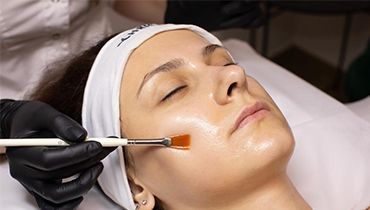Does Chemical Peeling Lighten the Skin? Benefits and Results

Chemical peeling has become a popular dermatological procedure for individuals seeking to improve their skin's appearance. One of the most frequently asked questions about this treatment is whether it can lighten the skin. In this blog post, we'll explore how chemical peels work, their benefits, and the results you can expect.
Understanding Chemical Peeling
Chemical peeling involves applying a chemical solution to the skin, which causes the top layers to exfoliate and eventually peel off. The new, regenerated skin underneath is usually smoother, less wrinkled, and more even in color. Chemical peels vary in strength, categorized into superficial, medium, and deep peels, each suited for different skin concerns and types.
Does Chemical Peeling Lighten the Skin?
Chemical peels can help lighten the skin by reducing the appearance of hyperpigmentation, dark spots, and uneven skin tone. Here's how:
The peeling process removes the outer layers of dead skin cells, which often contain excess melanin (the pigment responsible for skin color). This can help fade dark spots and achieve a more even skin tone. Peeling for skin lightening is particularly effective for those looking to address specific pigmentation issues.
Chemical peels stimulate the skin's natural healing process, increasing cell turnover. This helps replace damaged, pigmented skin cells with fresh, new cells.
Some chemical peels, especially deeper ones, can boost collagen production, improving skin texture and elasticity while also helping to lighten dark patches over time.
Benefits of Chemical Peeling:
Beyond lightening the skin, chemical peels offer a range of benefits:
Improvement in Skin Texture: Peels can smooth out rough skin, reducing the appearance of fine lines and wrinkles.
Chemical peels can help unclog pores and reduce acne breakouts. They also minimize the appearance of acne scars by promoting skin regeneration.
Peels can address sunspots, freckles, and other forms of sun damage, resulting in a more uniform complexion.
By removing the outermost layer of skin, chemical peels can enhance the absorption and effectiveness of skincare products.
Expected Results
The results of a chemical peel depend on the type and strength of the peel:
These light peels typically use alpha-hydroxy acids (AHAs) or beta-hydroxy acids (BHAs). They target the outer layer of skin, providing subtle improvements with minimal downtime. Results include brighter, more radiant skin and a reduction in mild pigmentation issues. They are considered a good option for a whitening chemical peel.
Using stronger acids like trichloroacetic acid (TCA), medium peels penetrate deeper into the skin. They can significantly reduce the appearance of age spots, fine lines, and moderate pigmentation issues. Expect a few days of downtime with peeling and redness. This is a popular choice for a chemical peel for brightening skin.
These peels, often using phenol, penetrate the deepest layers of skin. They provide the most dramatic results, effectively treating severe pigmentation, deep wrinkles, and significant sun damage. Recovery can take several weeks, and the skin may be red and swollen initially. They are often referred to as the best chemical peel for skin lightening.
Considerations and Aftercare
While chemical peels can offer remarkable benefits, it’s essential to follow proper aftercare to maximize results and minimize complications:
The new skin is more sensitive to the sun, so diligent use of sunscreen is crucial to prevent further pigmentation and protect the skin.
Keeping the skin well-moisturized helps in the healing process and reduces discomfort.
It’s important to avoid picking at peeling skin to prevent scarring and infection.
Conclusion:
Chemical peeling can effectively lighten the skin and address various skin concerns, from pigmentation to texture issues. By understanding the different types of peels and their benefits, you can make an informed decision about whether this treatment is right for you. Always consult with a qualified dermatologist to determine the best approach for your skin type and concerns. With proper care and professional guidance, chemical peels can be a transformative addition to your skincare routine. For those seeking the best chemical peel for skin lightening, Aura Clinic offers top-notch treatments that can help achieve brighter, more radiant skin.



